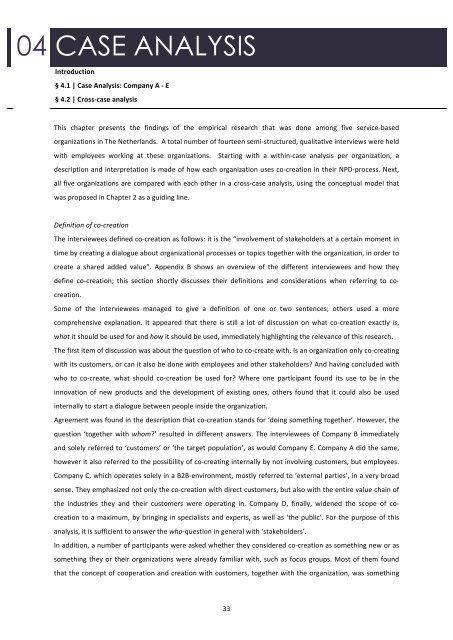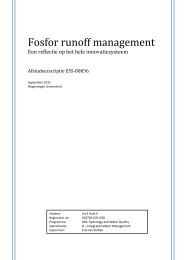Download PDF (English) - Future Ideas
Download PDF (English) - Future Ideas
Download PDF (English) - Future Ideas
Create successful ePaper yourself
Turn your PDF publications into a flip-book with our unique Google optimized e-Paper software.
Master thesis Business Administration, Specialization: Strategy & Organization <br />
04<br />
Supervisor:<br />
CASE<br />
Prof. Dr. T. Elfring <br />
ANALYSIS <br />
Introduction <br />
§ 4.1 | Case Analysis: Company A -‐ E <br />
§ 4.2 | Cross-‐case analysis <br />
Joost de Boer <br />
Student number 1517597 <br />
This chapter presents the findings of the empirical research that was done among five service-‐based <br />
organizations in The Netherlands. A total number of fourteen semi-‐structured, qualitative interviews were held <br />
with employees working at these organizations. Starting with a within-‐case analysis per organization, a <br />
description and interpretation is made of how each organization uses co-‐creation in their NPD-‐process. Next, <br />
all five organizations are compared with each other in a cross-‐case analysis, using the conceptual model that <br />
was proposed in Chapter 2 as a guiding line. <br />
Definition of co-‐creation <br />
The interviewees defined co-‐creation as follows: it is the “involvement of stakeholders at a certain moment in <br />
time by creating a dialogue about organizational processes or topics together with the organization, in order to <br />
create a shared added value”. Appendix B shows an overview of the different interviewees and how they <br />
define co-‐creation; this section shortly discusses their definitions and considerations when referring to co-creation.<br />
<br />
Some of the interviewees managed to give a definition of one or two sentences; others used a more <br />
comprehensive explanation. It appeared that there is still a lot of discussion on what co-‐creation exactly is, <br />
what it should be used for and how it should be used, immediately highlighting the relevance of this research. <br />
The first item of discussion was about the question of who to co-‐create with. Is an organization only co-‐creating <br />
with its customers, or can it also be done with employees and other stakeholders? And having concluded with <br />
who to co-‐create, what should co-‐creation be used for? Where one participant found its use to be in the <br />
innovation of new products and the development of existing ones, others found that it could also be used <br />
internally to start a dialogue between people inside the organization. <br />
Agreement was found in the description that co-‐creation stands for ‘doing something together’. However, the <br />
question ‘together with whom?’ resulted in different answers. The interviewees of Company B immediately <br />
and solely referred to ‘customers’ or ‘the target population’, as would Company E. Company A did the same, <br />
however it also referred to the possibility of co-‐creating internally by not involving customers, but employees. <br />
Company C, which operates solely in a B2B-‐environment, mostly referred to ‘external parties’, in a very broad <br />
sense. They emphasized not only the co-‐creation with direct customers, but also with the entire value chain of <br />
the industries they and their customers were operating in. Company D, finally, widened the scope of co-creation<br />
to a maximum, by bringing in specialists and experts, as well as ‘the public’. For the purpose of this <br />
analysis, it is sufficient to answer the who-‐question in general with ‘stakeholders’. <br />
In addition, a number of participants were asked whether they considered co-‐creation as something new or as <br />
something they or their organizations were already familiar with, such as focus groups. Most of them found <br />
that the concept of cooperation and creation with customers, together with the organization, was something <br />
33





